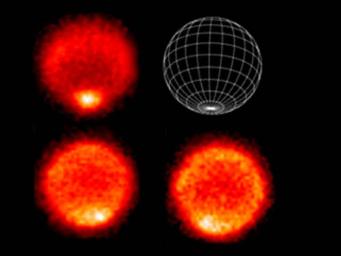
|
Neptune’s “Hot” South Pole
- Click the image above for a larger view
- Full-Res JPEG (720 x 540) (25.1 kB)
- Full-Res TIFF (720 x 540) (1.2 MB)
Caption:
These thermal images show a "hot" south pole on the planet Neptune. These warmer temperatures provide an avenue for methane to escape out of the deep atmosphere.
The images were obtained with the Very Large Telescope in Chile, using an imager/spectrometer for mid-infrared wavelengths on Sept. 1 and 2, 2006. The telescope is operated by the European Organization for Astronomical Research in the Southern Hemisphere (known as ESO).
Scientists say Neptune's south pole is "hotter" than anywhere else on the planet by about 10 degrees Celsius (50 degrees Fahrenheit). The average temperature on Neptune is about minus 200 degrees Celsius (minus 392 degrees Fahrenheit).
The upper left image samples temperatures near the top of Neptune's troposphere (near 100 millibar pressure, which is one-tenth the Earth atmospheric pressure at sea level). The hottest temperatures are indicated at the lower part of the image, at Neptune's south pole (see the graphic at the upper right). The lower two images, taken 6.3 hours apart, sample temperatures at higher altitudes in Neptune's stratosphere. They do show generally warmer temperatures near, but not at, the south pole. They also show a distinct warm area which can be seen in the lower left image and rotated completely around the back of the planet and returned to the earth-facing hemisphere in the lower right image.
Cataloging Keywords:
| Name | Value | Additional Values |
|---|---|---|
| Target | Neptune | |
| System | Neptune | |
| Target Type | Planet | |
| Mission | European Organization for Astronomical Research in the Southern Hemisphere (ESO) | |
| Instrument Host | ||
| Host Type | ||
| Instrument | Mid-infrared Camera/Spectrometer (VISIR) | Very Large Telescope (VLT) |
| Detector | ||
| Extra Keywords | Atmosphere, Color, Infrared, Methane, Rotation, Thermal | |
| Acquisition Date | ||
| Release Date | 2007-09-18 | |
| Date in Caption | ||
| Image Credit | VLT/ESO/NASA/JPL/Paris Observatory | |
| Source | photojournal.jpl.nasa.gov/catalog/PIA09927 | |
| Identifier | PIA09927 | |
